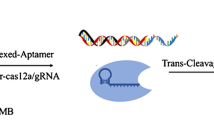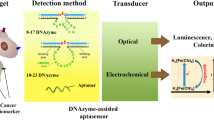Abstract
In this work, a surface plasmon resonance (SPR)-based assay for the quantification of antineoplastic drug irinotecan in human plasma samples has been developed for the first time. The selective binding of irinotecan with an aptamer receptor, operating in human plasma, allowed to set-up a novel analytical methodology to detect the drug in the analytical range of interest by using SPR as detection technique. After hybridizing the aptamer to the sensing platform and optimizing the sample preparation procedure, a quantitative assay was validated according to FDA regulatory guidelines. The analytical working range was found between 100 and 7500 ng mL−1 with negligible interferences from plasma components and co-medication associated with the administration of irinotecan. The utility of the new SPR assay was confirmed by analyzing plasma samples in parallel with LC-MS as reference technique, providing a new analytical tool for the therapeutic drug monitoring of irinotecan in patients under chemotherapy regimens.






Similar content being viewed by others
References
Conti JA, Kemeny NE, Saltz LB, Huang Y, Tong WP, Chou TC, et al. Irinotecan is an active agent in untreated patients with metastatic colorectal cancer. J Clin Oncol. 1996;14:709–15.
Rothenberg ML, Eckardt JR, Kuhn JG, Burris HA, Nelson J, Hilsenbeck SG, et al. Phase II trial of irinotecan in patients with progressive or rapidly recurrent colorectal cancer. J Clin Oncol. 1996;14:1128–35.
Tournigand C, André T, Achille E, Lledo G, Flesh M, Mery-Mignard D, et al. FOLFIRI followed by FOLFOX6 or the reverse sequence in advanced colorectal cancer: a randomized GERCOR study. J Clin Oncol. 2004;22:229–37.
Guo Y, Shi M, Shen X, Yang C, Yang L, Zhang J. Capecitabine plus irinotecan versus 5-FU/leucovorin plus irinotecan in the treatment of colorectal cancer: a meta-analysis. Clin Colorectal Cancer. 2014;13:110–8.
Chen K, Gong Y, Zhang Q, Shen Y, Zhou T. Efficacy and safety of addition of bevacizumab to FOLFIRI or irinotecan/bolus 5-FU/LV (IFL) in patients with metastatic colorectal cancer: a meta-analysis. Medicine (Baltimore). 2016;95:e5221. https://doi.org/10.1097/MD.0000000000005221.
Kotaka M, Xu R, Muro K, Park YS, Morita S, Iwasa S, et al. Study protocol of the Asian XELIRI ProjecT (AXEPT): a multinational, randomized, non-inferiority, phase III trial of second-line chemotherapy for metastatic colorectal cancer, comparing the efficacy and safety of XELIRI with or without bevacizumab versus. Chin J Cancer. 2016;35:102. https://doi.org/10.1186/s40880-016-0166-3.
Ohtsuka K, Inoue S, Kameyama M, Kanetoshi A, Fujimoto T, Takaoka K, et al. Intracellular conversion of irinotecan to its active form, SN-38, by native carboxylesterase in human non-small cell lung cancer. Lung Cancer. 2003;41:187–98.
Martino E, Della Volpe S, Terribile E, Benetti E, Sakaj M, Centamore A, et al. The long story of camptothecin: from traditional medicine to drugs. Bioorg Med Chem Lett. 2017;27:701–7.
Liu LF. DNA topoisomerase poisons as antitumor drugs. Annu Rev Biochem. 1989;58:351–75.
Hsiang YH, Liu LF, Wall ME, Wani MC, Nicholas AW, Manikumai G, et al. DNA topoisomerase I-mediated DNA cleavage and cytotoxicity of camptothecin analogues. Cancer Res. 1989;49:4385–9.
Mathijssen RHJ, Van Alphen RJ, Verweij J, Loos WJ, Nooter K, Stoter G, et al. Clinical pharmacokinetics and metabolism of irinotecan (CPT-11). Clin Cancer Res. 2001;7:2182–94.
Marangon E, Posocco B, Mazzega E, Toffoli G. Development and validation of a high-performance liquid chromatography-tandem mass spectrometry method for the simultaneous determination of Irinotecan and its main metabolites in human plasma and its application in a clinical pharmacokinetic study. PLoS One. 2015;10:1–18. https://doi.org/10.1371/journal.pone.0118194.
Canal P, Gay C, Dezeuze A, Douillard JY, Bugat R, Brunet R, et al. Pharmacokinetics and pharmacodynamics of irinotecan during a phase II clinical trial in colorectal cancer. Pharmacology and Molecular Mechanisms Group of the European Organization for Research and Treatment of Cancer. J Clin Oncol. 1996;14:2688–95.
Chabot GG. Clinical pharmacokinetics of irinotecan. Clin Pharmacokinet. 1997;33:245–59.
Widmer N, Bardin C, Chatelut E, Paci A, Beijnen J, Levêque D, et al. Review of therapeutic drug monitoring of anticancer drugs part two - targeted therapies. Eur J Cancer. 2014;50:2020–36.
Meneghello A, Tartaggia S, Alvau MD, Polo F, Toffoli G. Biosensing technologies for therapeutic drug monitoring. Curr Med Chem. 2018;25:4354–77.
Bardin S, Guo W, Johnson JL, Khan S, Ahmad A, Duggan JX, et al. Liquid chromatographic-tandem mass spectrometric assay for the simultaneous quantification of Camptosar® and its metabolite SN-38 in mouse plasma and tissues. J Chromatogr A. 2005:249–55.
D’Esposito F, Tattam BN, Ramzan I, Murray M. A liquid chromatography/electrospray ionization mass spectrometry (LC-MS/MS) assay for the determination of irinotecan (CPT-11) and its two major metabolites in human liver microsomal incubations and human plasma samples. J Chromatogr B Anal Technol Biomed Life Sci. 2008;875:522–30.
Alvau MD, Tartaggia S, Meneghello A, Casetta B, Calia G, Serra PA, et al. Enzyme-based electrochemical biosensor for therapeutic drug monitoring of anticancer drug irinotecan. Anal Chem. 2018;90:6012–9.
Idili A, Arroyo-Currás N, Ploense KL, Csordas AT, Kuwahara M, Kippin TE, et al. Seconds-resolved pharmacokinetic measurements of the chemotherapeutic irinotecan: in situ in the living body. Chem Sci. 2019;10:8164–70.
Temerk YM, Ibrahim H, Schuhmann W. Square wave cathodic adsorptive stripping voltammetric determination of the anticancer drugs flutamide and irinotecan in biological fluids using renewable pencil graphite electrodes. Electroanalysis. 2016;28:372–9.
Hatamluyi B, Es’haghi Z, Modarres Zahed F, Darroudi M. A novel electrochemical sensor based on GQDs-PANI/ZnO-NCs modified glassy carbon electrode for simultaneous determination of irinotecan and 5-fluorouracil in biological samples. Sensors Actuators B Chem. 2019;286:540–9.
Bonazza G, Tartaggia S, Toffoli G, Polo F, Daniele S. A fast method for the detection of irinotecan in plasma samples by combining solid phase extraction and differential pulse voltammetry. Anal Bioanal Chem. 2020;412:1585–95.
Tartaggia S, Alvau MD, Meneghello A, Casetta B, Polo F, Toffoli G. Practical fluorimetric assay for the detection of anticancer drug SN-38 in human plasma. J Pharm Biomed Anal. 2018;159:73–81.
Dunn MR, Jimenez RM, Chaput JC. Analysis of aptamer discovery and technology. Nat Rev Chem. 2017;1:0076. https://doi.org/10.1038/s41570-017-0076.
Hearty S, Leonard P, Ma H, O’Kennedy R. Measuring antibody-antigen binding kinetics using surface plasmon resonance. In: Nevoltris D, Chames P, editors. Antibody engineering. methods in molecular biology, vol. 1827. New York: Humana Press; 2018. p. 421–55. https://doi.org/10.1007/978-1-4939-8648-4_22.
Cannon MJ, Papalia GA, Navratilova I, Fisher RJ, Roberts LR, Worthy KM, et al. Comparative analyses of a small molecule/enzyme interaction by multiple users of Biacore technology. Anal Biochem. 2004;330:98–113.
Chang AL, McKeague M, Liang JC, Smolke CD. Kinetic and equilibrium binding characterization of aptamers to small molecules using a label-free, sensitive, and scalable platform. Anal Chem. 2014;86:3273–8.
Bialas K, Reinemann C, Barnes E, Bunka D, Tolley A Aptamer against irinotecan. Patent Application WO2020128421 A1, 2020.
Food and Drug Administration, in: Guidance for Industry Bioanalytical Method Validation draft guidance. 2013. http://www.fda.gov/downloads/Drugs/GuidanceComplianceRegulatoryInformation/Guidances/UCM368107.pdf. Accessed 9 May 2017.
Liu Y, Wilson WD. Quantitative analysis of small molecule–nucleic acid interactions with a biosensor surface and surface plasmon resonance detection. In: Fox K, editor. Drug-DNA interaction protocols. Methods in Molecular Biology (Methods and Protocols), vol. 613. New York: Humana Press; 2010. p. 1–23. https://doi.org/10.1007/978-1-60327-418-0_1.
Stoltenburg R, Nikolaus N, Strehlitz B. Capture-SELEX: selection of DNA aptamers for aminoglycoside antibiotics. J Anal Methods Chem. 2012;415697:1–14. https://doi.org/10.1155/2012/415697.
Combes O, Barré J, Duché JC, Vernillet L, Archimbaud Y, Marietta MP, et al. In vitro binding and partitioning of irinotecan (CPT-11) and its metabolite, SN-38, in human blood. Investig New Drugs. 2000;18:1–5. https://doi.org/10.1023/A:1006379730137.
Situ C, Wylie ARG, Douglas A, Elliott CT. Reduction of severe bovine serum associated matrix effects on carboxymethylated dextran coated biosensor surfaces. Talanta. 2008;76:832–6.
Azadeh M, Gorovits B, Kamerud J, MacMannis S, Safavi A, Sailstad J, et al. Calibration curves in quantitative ligand binding assays: recommendations and best practices for preparation, design, and editing of calibration curves. AAPS J. 2018;20:22. https://doi.org/10.1208/s12248-017-0159-4.
Corona G, Elia C, Casetta B, Toffoli G. Fast liquid chromatography-tandem mass spectrometry method for routine assessment of irinotecan metabolic phenotype. Ther Drug Monit. 2010;32:638–46.
Funding
This work was supported by the Italian Ministry of Health (Ricerca Corrente). We acknowledge Regione Friuli-Venezia-Giulia trough the POR FESR 2014–2020 (project “Nano Diagnostics and Automated Tools for Oncology,” NADIATools) and the grant AIRC 5X1000 (Rif. 12214) “Application of advanced nanotechnology in the development of innovative cancer diagnostics tools” for financial support.
Author information
Authors and Affiliations
Corresponding author
Ethics declarations
Conflict of interest
D. Bunka is a Co-founder and Director of Aptamer Group and therefore has financial interest in Aptamer Group Ltd. A. Puscasu, M. Zanchetta, B. Posocco, S. Tartaggia, and G. Toffoli have no conflicts to declare regarding the publication of this manuscript.
Ethics approval
Plasma samples were collected from patients enrolled in a phase Ib clinical study (CRO-2009-25, Prot. n. 0041793(09)-PRE.21-984) approved by the ethics committee of CRO-National Cancer Institute of Aviano (Italy) and by Istituto Superiore di Sanità (ISS, Italy), which was conducted according to the principles expressed in the Declaration of Helsinki. Informed consent was obtained from all participants involved in the study.
Source of biological material
Control human plasma stabilized with K2EDTA for the preparation of daily standard calibration curves and quality control (QC) samples was obtained from healthy volunteers and was provided by the Transfusion Unit of the Centro di Riferimento Oncologico di Aviano (CRO), Italy.
Additional information
Publisher’s note
Springer Nature remains neutral with regard to jurisdictional claims in published maps and institutional affiliations.
Supplementary information
ESM 1
(DOCX 682 kb).
Rights and permissions
About this article
Cite this article
Puscasu, A., Zanchetta, M., Posocco, B. et al. Development and validation of a selective SPR aptasensor for the detection of anticancer drug irinotecan in human plasma samples. Anal Bioanal Chem 413, 1225–1236 (2021). https://doi.org/10.1007/s00216-020-03087-5
Received:
Revised:
Accepted:
Published:
Issue Date:
DOI: https://doi.org/10.1007/s00216-020-03087-5




